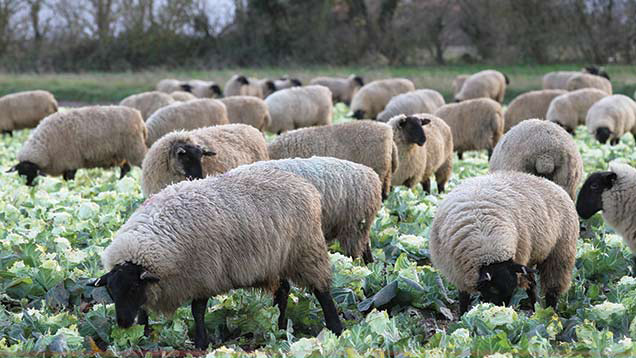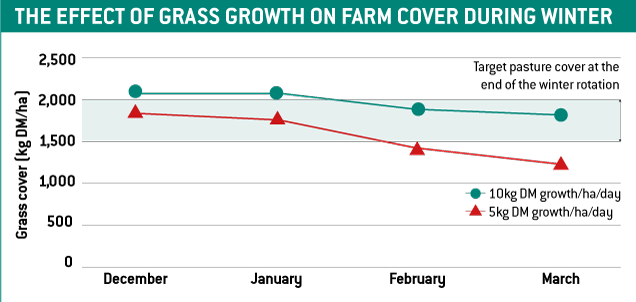Tips to help livestock farmers plan a winter feed budget

Planning a winter feed budget allows decisions to be made early, before feed shortages occur, and provides a plan to help manage pasture throughout the season.
It is a simple calculation, based on the number of animals, their weight and predicted feed intakes, and grazing area information.
Walk the fields
First, walk the fields that will be grazed during winter and measure how much grass is there now.
AHDB Beef and Lamb has produced a sward stick that converts compressed sward heights into kilogrammes of dry matter per hectare (kg DM/ha) to make this easy.
See also: Top tips for calculating a winter feed budget
It is also important to calculate the available feed in brassica fields or deferred grazing.
To do this, remove and weigh the material from the equivalent of a 1sq m area and multiply by 10 to get tonnes freshweight per hectare (5kg of fresh weight/sq m equates to 50t/ha).
Then multiply by the dry matter percentage to get DM/ha in tonnes (50 x (10/100) = 5t DM/ha).
Calculate supply and demand
Next, work out supply and demand.
A simple example is shown in the table below. Here, 950 mature ewes are being rotationally grazed for 100 days from 1 December to 20 March, just before they lamb.
Prior to scanning (during December and January) they are allocated enough daily feed to give them 1.5% of their bodyweight, which is about 1kg DM/day. After scanning, they are allocated more.
|
Supply and demand (Initial cover 2,000kg DM/ha) |
||||
|
Dec |
Jan |
Feb |
Mar |
|
|
Grazing area (ha) |
110 |
110 |
110 |
110 |
|
Grazing days |
31 |
31 |
28 |
20 |
|
Net growth rate (kg DM/ha/day) |
10 |
10 |
10 |
10 |
|
Animal intakes |
||||
|
Number of ewes |
950 |
950 |
950 |
950 |
|
Weight (kg) |
65 |
67 |
69 |
70 |
|
Intake (% of bodyweight) |
1.5 |
1.5 |
2.7 |
2.7 |
|
Daily intake (kg DM) |
1.0 |
1.0 |
1.9 |
1.9 |
|
Total daily requirement (kg DM) |
950 |
950 |
1,770 |
1,796 |
|
Total monthly animal intake (kg DM) |
29,450 |
29,450 |
49,556 |
35,920 |
|
Animal intake per ha (kg DM/ha/day) |
8.6 |
8.6 |
16.0 |
16.3 |
|
Growth-intake difference (kg DM/ha/day) |
1.4 |
1.4 |
-6.0 |
-6.3 |
|
Average farm cover (kg DM/ha) |
2,043 |
2,086 |
1,919 |
1,793 |
Total daily requirement is calculated from the individual intake multiplied by the group size.
Monthly intake is derived by multiplying daily requirement by the number of grazing days.
Intake per hectare is calculated by dividing the daily requirement by the total grazing area allocated to this class of stock.
This then allows a comparison between grass growth and what the animals need to eat.
In this example, there is enough grass in December and January (10kg DM/ha/day growth versus 8.6kg DM/day feed required), but a shortfall in February and March (10kg DM/ha/day growth versus 16kg and 16.3kg DM/day feed required).
The average farm cover (or amount of grass available at any one time), is calculated from the difference between growth and intake, multiplied by the number of grazing days in that month and added to the cover from the previous month.
It can then be plotted on a graph to see what is happening to grass growth during the winter.
In the graph above, the green line assumes 10kg DM growth/ha a day and shows that cover is maintained above or within target for the four-month period.
However, if the grass grows more slowly (5kg DM/ha a day) the predicted cover drops out of target by the end of February.
This means the target for lambing cover will not be achieved.
It is worth playing around with a winter feed budget, looking at the effect of various grass growth predictions, to gauge the best- and worst-case scenarios.
It can also be useful to monitor actual grass growth over winter, plotting the results against the estimated figures.

Predicting turnout
Where animals are housed, it is still useful to monitor grass throughout winter to help decide when to let the animals outside.
For example, if the amount of grass in the fields at the start of the winter period is 1,500kg DM/ha and grass growth averages 5kg DM/day for a month, there should be 150kg DM (5kg x 30) more grass available by the end of the first month.
If feeds are being given outside, the demand for the grass that is growing is lower, as some or most of the animals’ intake will come from the supplements.
For example, cattle weighing 350kg have a predicted individual intake of 10.5kg (3% of bodyweight).
If there are 30 in a group, they will have a total daily group demand of 315kg DM/day.
One silage bale of 250kg DM lasts them two days, which means they are each eating roughly 6kg DM of grass every day ((315-125)/30), and that means they will not be eating very much grazed grass.
